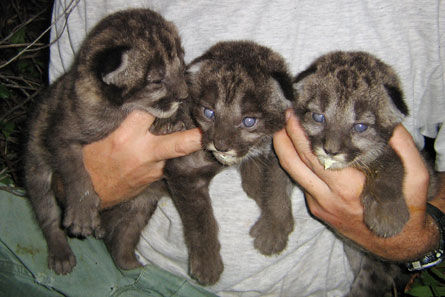Plenty of people hated the idea in 1995, but borrowing some genes from Texas has improved prospects for endangered Florida panthers, a new report says.

Hybrids of the Florida cats and cousins of the same species from a wild-caught Texas population have twice the genetic variety and far fewer of the genetic defects that were known in Floridian panthers before the introduction, says geneticist Warren Johnson of the National Cancer Institute in Frederick, Md.
Now panthers of mixed-state background live about twice as long as the pure Floridians do. Thanks to the genetic infusion and other conservation measures, the adult panther population in Florida has tripled, Johnson and his colleagues report in a broad review of the effort published in the Sept. 24 Science. Wildlife managers now put adult panther numbers in the 90s, sometimes pushing into three digits during a banner year.
“This work can be a good model for other severely depleted populations of carnivores,” says longtime cat conservation biologist Howard Quigley, based in Bozeman, Mont. But Florida’s panthers are far from safe, he points out.
Among the big remaining questions is whether Florida will find enough habitat for a population to survive. A mere hundred Florida panthers don’t make a viable population in the long term.
“The Florida panther represents the increasing reality for many large carnivores in the world today: small isolated populations,” Johnson says.
The species of big cat called a puma, cougar or panther once prowled a variety of landscapes across much of North and South America. As people rushed into Florida, panther territory shrank, and decades ago the big cats were widely believed to have gone extinct, Johnson says. In the 1970s, though, a biologist traced down some rumors and found a tiny population of panthers hanging on in southern Florida.
The two dozen or so adult Florida panthers had troubles aplenty, what with real estate booms and lethal highway traffic on Alligator Alley and other highways. But wildlife managers also found disturbing proportions of cats with poor sperm quality, low fertility, undescended testicles, heart valve defects, kinked tails and fur anomalies that looked like cowlicks. These signs suggest inbreeding, which biologists feared was reducing survival.
Since Florida panthers in their glory days should have been part of a gene interchange that included Texas, biologists proposed importing just eight females and releasing them strategically in south Florida.
The plan was “highly discussed,” as Johnson puts it. Introducing genes from animals in a different habitat carries the risk of diluting some valuable local trait. Wildlife managers, whose daily concerns included panthers getting killed on highways or pushed back by housing development, had doubts about whether a little genetic variety was going to help much. Also, this was the iconic Florida panther, not the Floritexan panther.
Biologists have monitored the population carefully since the Texan females arrived in the mid-1990s, and the new paper is the most comprehensive look yet at the effects of the gene infusion, Johnson says.
In reporting the success, he makes a point of acknowledging the support of human Floridians. Conservationists around the world lament that internationally beloved species like tigers and lions often don’t generate much enthusiasm from their up-close neighbors.
“Large carnivores aren’t always easy to live with,” Johnson says.
Substantial funding for the genetic rescue effort, Johnson says, has come from people choosing to pay a $25 premium for a “Protect the Panther” Florida license plate.
“Most importantly, though,” Quigley says, “we must do all we can to not let this sort of population constriction happen again.”






